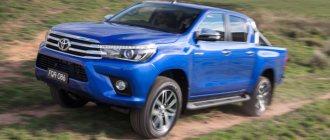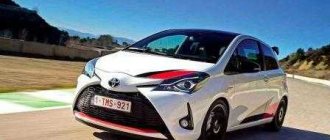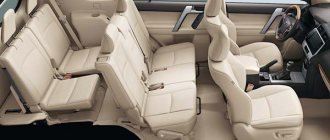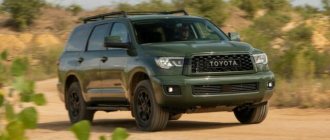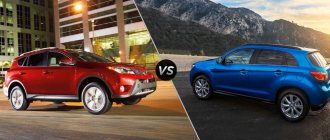If you put them together, it will not be difficult to find common features and lines, but no one will call them the same. If you look under the hood or underbody, it becomes clear that these are siblings. But it's not that simple. In appearance and technically they may be very close, but their essence is very different. In order to understand “who is who,” let’s talk about the maximum configurations of these cars (Lexus is the only one that happens) ) ) ) )
Of course, “all markers are different in taste and color”! I hasten to state this. Let me just say that I like all three cars in their own way =)
Camry
the most classic.
Smooth lines, rounded shapes - a real Japanese Toyota. There is no flashy design impulse in it, but not everyone wants to stand out from the crowd. Avalon
is rough, it looks massive, and when reflected in the rearview mirror, you immediately give way.
For all its angularity, the coefficient of resistance to air flow is incredibly low, only 0.29 Cd.
I would call the ES Narrow headlights, rounded line of the rear side window, not a wide grille, in general, Lexus, period. The main thing here is the nameplate.
But if you can choose by design based on personal preferences and taste, then dry numbers indicate the following:
Length: Camry-4865 mm, Avalon-5010 mm, ES-4855 mm. Width: Camry-1820 mm, Avalon-1850 mm, ES-1820 mm. Base: Camry-2775 mm, Avalon-2820 mm, ES-2775 mm.
Thus, it is obvious that the dimensions of the Camry and Es are identical, while the Avalon is noticeably larger. This difference is especially felt in the cabin. Space is the great American's main trump card.
And again I want to say “taste and color,” but options decide everything. I will not provide complete lists of all possible additional devices for each car; this can be found on any official website. The rest is subjective, see the photo.
Technical characteristics: V6 engine is the same for all. In general, the performance of the 3.5 liter is equivalent. The chassis differs only in settings and perhaps some small details.
New or used car?
For 2021, Toyota is implementing several significant improvements to the Avalon lineup. The most important of these is the option of a 2.5-liter four-cylinder engine with all-wheel drive on the XLE and Limited trims. The brand has also finally decided to add Android Auto feature, which now comes as standard. Modern USB charging ports have also been installed on every trim level.
Additionally, Toyota is introducing the XSE Nightshade Edition with black accents on the outside. The new Toyota Avalon is definitely worth attention.
Toyota Avalon or Toyota Camry
Toyota Camry is a mid-size car. Both the Camry and Avalon come standard with a large number of advanced safety features, and both have user-friendly infotainment systems. The Camry comes with a four-cylinder engine and is available with a V6, while the Avalon comes standard with a V6 or four-cylinder engine. The choice between these two cars comes down to price and passenger space. Go for the Avalon if you want maximum rear-seat space. If you can do without the extra passenger space, consider opting for the more affordable Camry.
How we tested the 2021 Toyota Avalon
Toyota Aurion cost
There are three kits for Toyota Aurion to choose from. Optional equipment is also plentiful. The most inexpensive cars with fabric interiors cost 36 thousand dollars. They have 16-inch wheels and electrically adjustable seats.
Sports Toyota Aurion with a cost of 41 thousand dollars. They have sports body kits, 18-inch wheels and sports suspension elements. These cars have audio devices with 10 speakers and sunroofs, but this is optional.
The most expensive Presara kits can be purchased for 50 thousand dollars.
Toyota Avalon or Kia Cadenza
The Kia Cadenza is a stunning big car. Both the Kia and Toyota sedan have spacious, upscale interiors and decent trunks. However, the Cadenza comes with a long list of standard safety features and a large touchscreen. But the Avalon uses less fuel, accelerates faster and offers all-wheel drive. The choice will depend on personal preference.
Read also
How we tested the 2019 Toyota Avalon
Speed
Drag coefficient is one measurement of how well air flows around a vehicle. A lower coefficient means that the car is more aerodynamic and the engine does not have to work as hard as it can. The result is higher speed and greater fuel economy.
That's as it should be, considering the 2021 Avalon is priced at $36,395, or more than $10,000 above the starting price of the Camry's four-cylinder base model, which nonetheless shares many of the Avalon's core benefits.
The relative improvement in the interior compared to its midsize siblings is the 2019 Avalon's biggest improvement over its predecessor.
The top of the 2021 Toyota Avalon's dashboard isn't very high, especially compared to the Camry, and that makes the big sedan feel a little airier inside. This is partly possible thanks to the thin ventilation holes located under the touchscreen. Chief designer O. Schneider says the interior design goal was to combine the spaciousness expected of an Avalon with the feel of a cozy cabin.
Toyota Avalon 2019 interior
The way the center console rises between the driver and front passenger to become the central control stack is an interesting design, and we're glad that the standard 9.0-inch touchscreen (with standard Apple CarPlay but no Android Auto) is in top of the dashboard.
Salon
Avalon is a five-seater cabin. Both rows offer ample space and no passenger will have any complaints even on long journeys. The Avalon is a big car, so its wide-opening doors and spacious interior make getting in and out easy.
Each version of the Toyota Avalon has a unique interior design. XLE trim seats are upholstered in SofTex, which is available in Harvest Beige, Black or Graphite. XSE and Touring upgrade the interior with original aluminum accents. The TRD uses the same upholstery materials. But as the sportiest version on offer, it gets a premium leather steering wheel and shifter with embossed red logo and contrast stitching, as well as red TRD badging and cloth inserts and belts. Those who prefer leather upholstery will have to choose the Limited, which comes in three colors: Graphite, Cognac or Black. It is also the only interior version with natural wood accents.
In the full-size sedan class, the Avalon impresses with practicality, offering a generous 455-litre boot.
The Avalon's standard infotainment interface is easy to use. The system comes with touch screen and physical controls. Android Auto, previously unavailable in the Avalon, has now been added as standard equipment.
Interior
Everything in the Toyota Aurion corresponds to the declared class. And the most discerning car enthusiasts will be satisfied:
- finishing material;
- salon space designs;
- shades and assembly of nodes;
- three-zone climates;
- comfortable chairs;
- buttons on steering wheels;
- instrument panels with two large round analogue gauges, which have beautiful backlights;
- on-board computer screens with good image and readability;
- multimedia screens;
- convenient locations of electronic assistants.
Specifications
The Toyota Avalon comes standard with a 301-horsepower V6 engine and front-wheel drive. XLE and Limited models come with a free 205-horsepower four-cylinder engine and all-wheel drive. V6 trims are more powerful and accelerate faster, but all-wheel drive versions offer better traction. Each model is equipped with an eight-speed automatic transmission.
Acceleration of a standard Toyota Avalon to 100 km/h takes 7.7 seconds.
Equipped with a 2.5-liter four-cylinder engine, eight-speed automatic transmission and all-wheel drive, the sedan's fuel economy is a truly impressive 8.4 L/100 km.
The Avalon has composed handling and a smooth ride on any road. An upgraded TRD model is available with a firmer suspension and lower ride height, but it's still more focused on comfort than sportiness.
Exterior of Toyota Aurion
Externally, Toyota Aurion is enviable. They are strict. They do not flaunt sportiness and aggressiveness. Ordinary classic business class cars.
Frontal view with narrow optical instruments. They are similar in shape to a parallelogram. They have lensed filling. Between them are radiator grilles, decorated with chrome inserts and company logos. Bumpers with continued grilles and round foglights, also with chrome inserts.
On the sides there are large wheel arches, small stampings in the lower body parts and elegant lines at the top. Feed with strict lighting fixtures, large, practical trunk lids. They also have chrome inserts. Rear bumpers with reflectors and two exhaust pipes.
Important! Buyers have a choice of eight body colors.
Engines along with technical characteristics
Toyota Aurion has three types of engines:
Four-cylinder 2.0 l., with 140 l. With.
The same for 2.4 liters, with 180 hp.
Six-cylinder 3.7 liters, with 268 liters. With.
The engines operate with six-speed automatic transmissions. Cars with 2.4 liter units can be combined with CVTs or automatic transmissions, according to your choice.
Series with TRD have been released for Australians. They have improved 6-cylinder turbo engines of 3.5 liters. With a power of 323 hp. Costs - 10l./100 km. With acceleration in 6.1 seconds.

